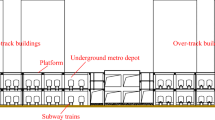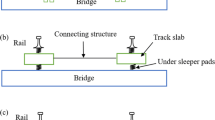Abstract
Results of in-situ vibration measurement carried out at Tianjin West Elevated Railway Station which has the trains running on the station structure were reported. The main excitation source is the train passing through the station. Vibration measurements were recorded in the vertical direction of the supporting track beam, the platform and the steel truss beam of the waiting hall, as well as in the vertical, longitudinal and transverse directions of the roof arch base of the station. Acceleration time responses were obtained. The maximum value, vibration level and one-third octave band RMS spectra of the measured accelerations were studied. The propagation of vibration in different structural floors was discussed. The influence of train speed, distance to the vibration source and the type of train on the structural vibration were analyzed. Results show that the vibration level increases with the train speed, while it attenuates with the distance to the track. Furthermore, the vibration responses of different structural floors were compared, and it is noted that the vertical vibration of the bottom slab of the platform is most severe and the transverse vibration of the roof arch base is the smallest. The results provide reference on the vibration characteristics and vibration energy distribution of this type of “Train on building frame” system used as an elevated railway station.
Similar content being viewed by others
References
XIA He, ZHANG Nan, CAO Yan-mei. Experimental study of train-induced vibrations of environments and buildings [J]. Journal of Sound and Vibration, 2005, 280(3/4/5): 1017–1029.
ZHANG Nan, XIA He. Comfort analysis of the new Guangzhou Railway Station [C]// Proceedings of the Second International Conference on Structural Condition Assessment, Monitoring and Improvement. Changsha: Science Press, 2007: 1434–1440.
CHENG Qian, ZHANG Nan, XIA He. Train-induced structural vibrations of elevated railway station [C]// Environment Vibration: Prediction, Monitoring and Evaluation. Beijing: Science Press, 2009: 178–183.
PICHAI P, SUWAJCHAI P. Predicting mass rapid transit noise levels on an elevated station [J]. Journal of Environmental Management, 2003, 67(4): 353–362.
LIU K, REYNDERS E, DEROECK G, LOMBAERT G. Experimental and numerical analysis of a composite bridge for high-speed trains [J]. Journal of Sound and Vibration, 2009, 320(1/2): 201–220.
XIA He, CAO Yan-mei, DEROECK G. Theoretical modeling and characteristic analysis of moving-train induced ground vibrations [J]. Journal of Sound and Vibration, 2010, 329(7): 819–832.
DING De-yun, LIU Wei-ning. Prediction of vibrations from underground trains on Beijing metro line 15 [J]. Journal of Central South University of Technology, 2010, 17(5): 1109–1118.
YAN Bin, DAI Gong-lian, ZHANG Hua-ping. Beam-track interaction of high-speed railway bridge with ballast track [J]. Journal of Central South University of Technology, 2012, 19(4): 1447–1453.
JU Shen-haw, LIN Hung-ta, HUANG Jeng-yuan. Dominant frequencies of train-induced vibrations [J]. Journal of Sound and Vibration, 2009, 319(1/2): 247–259.
BATTINI J, MAHIR U. A simple finite element to consider the non-linear influence of the ballast on vibrations of railway bridges [J]. Engineering Structures, 2011, 33(9): 2597–2602.
BIONDIA B, MUSCOLINOB G, SOFIB A. A substructure approach for the dynamic analysis of train-track-bridge system [J]. Computers & Structures, 2005, 83(11): 2271–2281.
SHANG Ying-chun, QI Hong-yuan. Automatic testing system design and data analysis of permafrost temperature in Qinghai-Tibet Railway [J]. Journal of Central South University of Technology, 2008, 15(s2): 352–356.
KIMA D, LEE J. Propagation and attenuation characteristics of various ground vibrations [J]. Soil Dynamics and Earthquake Engineering, 2000, 19(2): 115–126.
HALL L. Simulations and analyses of train-induced ground vibrations in finite element models [J]. Soil Dynamics and Earthquake Engineering, 2003, 23(5): 403–413.
JU S, LIN H, CHEN T. Studying characteristics of train-induced ground vibrations adjacent to an elevated railway by field experiments [J]. Journal of Geotechnical and Geoenvironmental Engineering, 2007, 133(10): 1302–1307.
DEGRANDEA G. Vibrations due to a test train at variable speeds in a deep bored tunnel embedded in London clay [J]. Journal of Sound and Vibration, 2006, 293(3/4/5): 626–644.
Author information
Authors and Affiliations
Corresponding author
Additional information
Foundation item: Project(50938008) supported by the Natural Science Foundation of Beijing, China; Project(2012JBM007) supported by the Fundamental Research Funds for the Central Universities, China; Project(NCET-11-0571) supported by the Program for New Century Excellent Talents in University, China
Rights and permissions
About this article
Cite this article
Yang, N., Guo, T. & Sun, Gz. Train-induced vibration on elevated railway station. J. Cent. South Univ. 20, 3745–3753 (2013). https://doi.org/10.1007/s11771-013-1903-2
Received:
Accepted:
Published:
Issue Date:
DOI: https://doi.org/10.1007/s11771-013-1903-2




